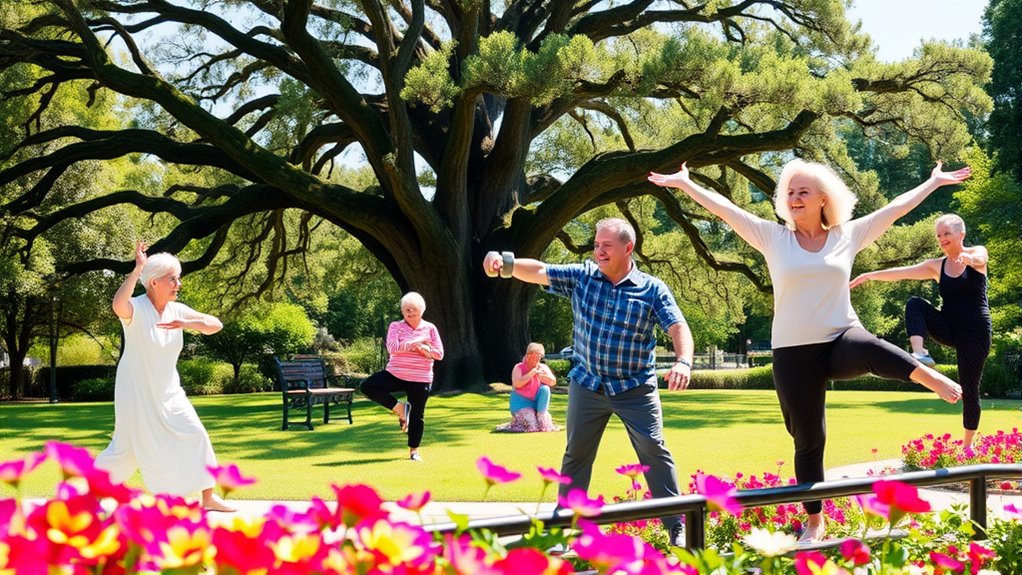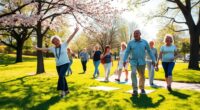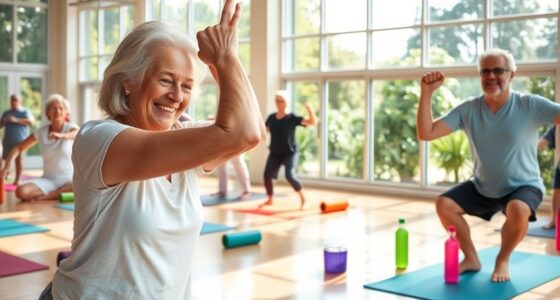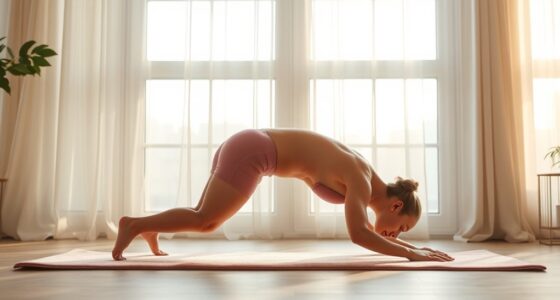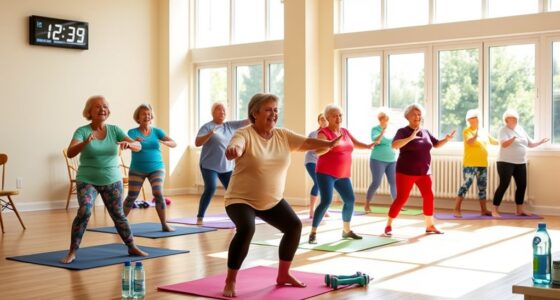To create the perfect exercise program, aim for at least 150 minutes of moderate aerobic activity weekly. Mix in strength training twice a week and balance exercises three times a week to reduce fall risk. Incorporate low-impact options like walking, swimming, or tai chi to boost cardio health without straining your joints. Don’t forget daily stretching for flexibility. Remember to consult with a healthcare provider and adjust your routine based on your abilities. Discover more ways to enhance your fitness journey!
Key Takeaways
- Aim for at least 150 minutes of moderate-intensity aerobic activity weekly, such as walking or swimming.
- Incorporate muscle-strengthening exercises on two or more days each week using light weights or resistance bands.
- Practice balance exercises like tai chi or standing on one leg at least three times a week to reduce fall risk.
- Include daily stretching routines to improve flexibility and alleviate joint pain, holding each stretch for 10 to 30 seconds.
- Utilize resources like SilverSneakers for guided workouts and community support to maintain motivation and engagement.
Health Benefits of Exercise for Seniors

When you engage in regular exercise, you not only boost your physical health but also enhance your mental well-being.
For seniors, physical activity plays a vital role in maintaining muscle strength and balance, which are essential for fall prevention. By incorporating exercise into your routine, you markedly reduce the risk of chronic diseases like heart disease, diabetes, and obesity, promoting overall health and longevity. Additionally, creating safe living environments can further support your physical activity efforts. Engaging in physical activity also helps in protecting seniors from financial scams by fostering a sense of community and awareness. Regular exercise can also lead to improved cognitive function, which is crucial for maintaining independence in later years. Furthermore, seeking professional help can enhance motivation and adherence to an exercise program tailored for seniors.
Regular physical activity is crucial for seniors, enhancing strength, balance, and reducing chronic disease risks for a healthier, longer life.
Regular workouts can improve your mood and cognitive function, reducing anxiety and depression symptoms. You’ll likely experience better sleep quality, allowing for improved rest and recovery.
Ultimately, seniors who stay active often report a higher quality of life, increased energy levels, and more opportunities for social interaction through group activities. Engaging in regular exercise can also help meet your emotional needs, similar to how dogs thrive with physical activity and mental stimulation.
Embrace the benefits of exercise!
Recommended Exercise Frequency
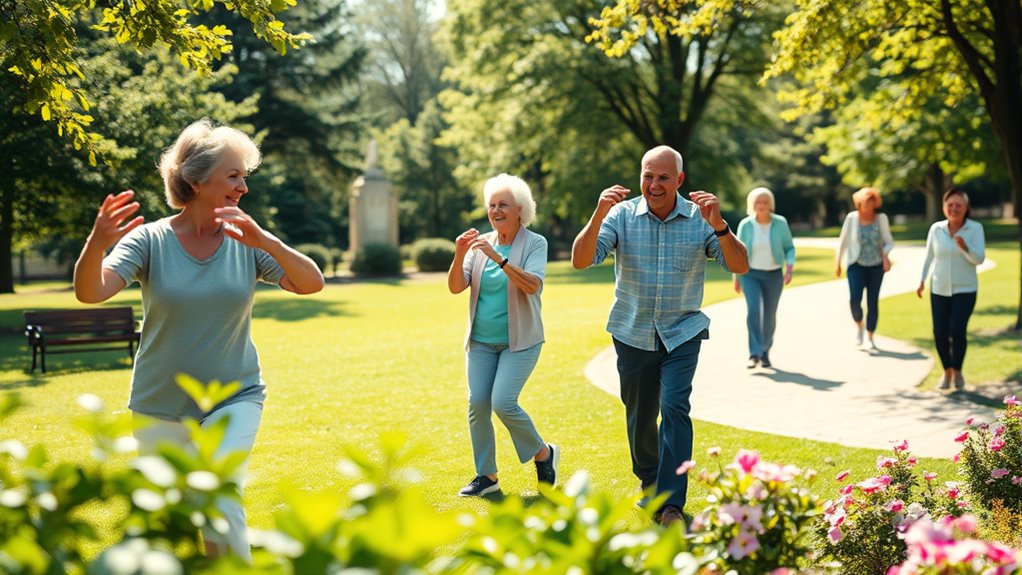
Staying active is essential for seniors, and knowing how often to exercise can make a significant difference in your health journey. The CDC recommends that older adults aim for at least 150 minutes of moderate-intensity aerobic activity each week. You can break this down into shorter sessions of 10 to 15 minutes throughout the day. Additionally, regular physical activity can improve overall health and enhance your quality of life. Engaging in self-care practices through exercise can also boost your mental well-being. Maintaining a consistent routine can help manage production quantity variance in your fitness program, ensuring that you stay on track with your goals. Incorporating spiritual practices into your routine may further enrich your overall wellness experience.
In addition to aerobic activities, incorporate muscle-strengthening exercises on two or more days each week to boost strength and mobility. Don’t forget about balance exercises; practicing them at least three times a week can help prevent falls. Regular exercise is vital for maintaining breast cancer awareness, as staying fit can support overall health and well-being.
Adjust your recommended exercise frequency based on your personal abilities and any existing health conditions to guarantee a safe and effective regimen that keeps you fit and healthy.
Key Types of Exercises for Seniors
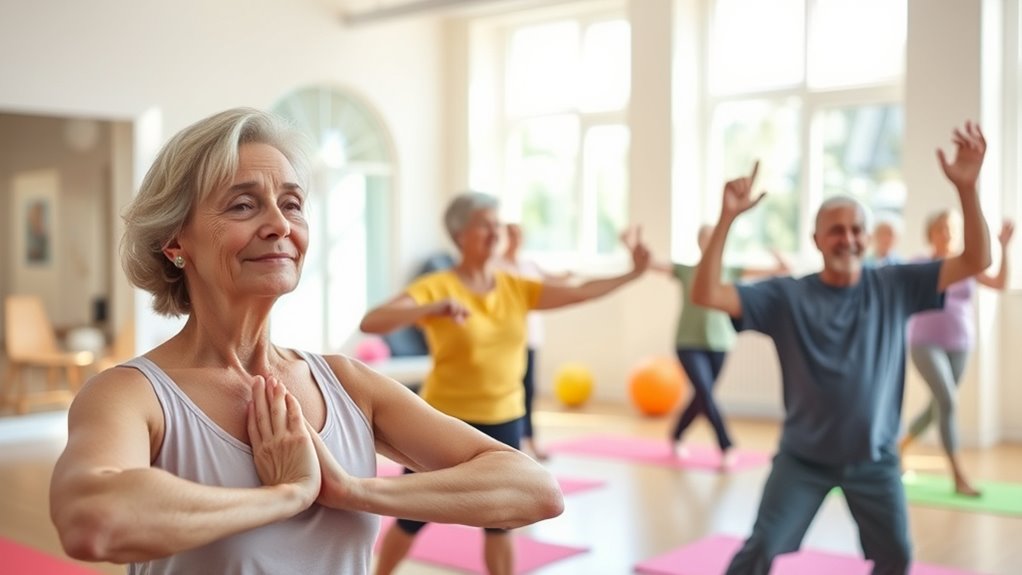
Engaging in a variety of exercises is essential for seniors to maintain overall health and well-being. Incorporate aerobic activities like walking or swimming for at least 150 minutes weekly to boost cardiovascular fitness. Additionally, participating in educational toys and activities can enhance cognitive functioning and promote overall mental health. Regular exercise can also help prevent heat pump failure by improving overall physical health, which is crucial for maintaining an active lifestyle. A well-rounded approach to fitness can include using portable camping toilets for convenience during outdoor activities. Moreover, powerful words can serve as motivation for seniors to stay committed to their fitness goals.
Strength training for seniors is vital too; aim for muscle-strengthening activities at least two days a week to preserve muscle mass and bone density, aiding fall prevention. To improve balance, practice exercises such as tai chi or standing on one leg three times a week.
Flexibility training, including daily stretching, enhances your range of motion and alleviates joint pain. Finally, consider low-impact activities like yoga and Pilates to build strength and improve balance without stressing your joints. Additionally, incorporating low carb foods into your diet can support overall fitness and energy levels.
These exercises create a well-rounded fitness routine tailored for seniors.
Strength Training Exercises
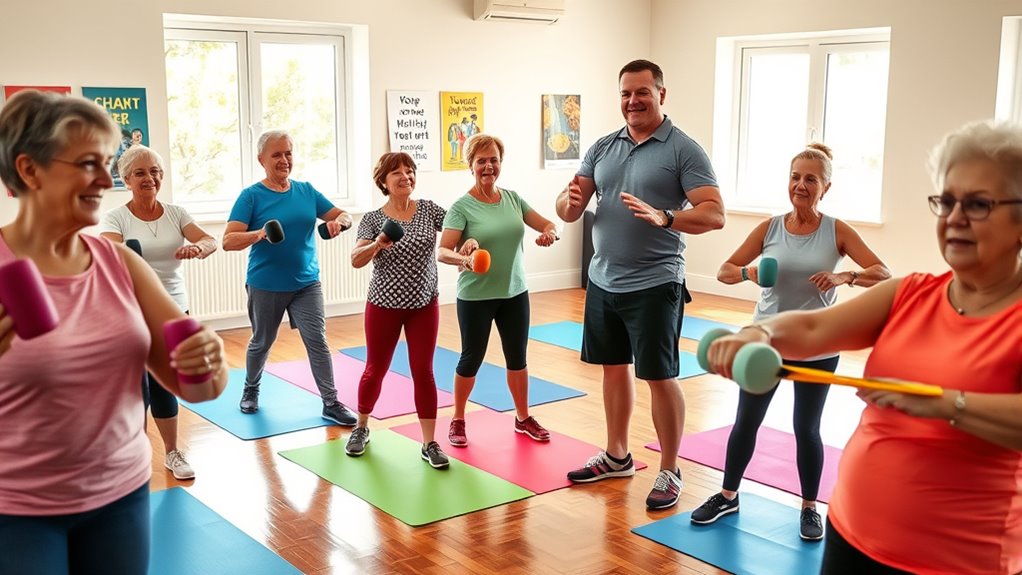
Strength training exercises are essential for seniors, as they help maintain muscle strength, improve bone density, and enhance overall mobility. Incorporating simple movements like chair squats, bicep curls, and knee lifts into your routine can be highly effective. Start with one set of 12 repetitions and gradually work your way up to three sets. Using resistance bands and light weights makes these exercises manageable while still challenging.
Strength training is crucial for seniors, supporting muscle strength, bone density, and mobility.
Aim to engage in strength training at least once or twice a week, allowing for rest days to promote recovery. Remember, safety during workouts is vital; focus on proper form and start slowly. If you experience any pain or discomfort, consult your healthcare provider. Additionally, consider using safe, durable toys that encourage movement and fitness as part of your exercise regimen. Engaging in fitness programs specifically designed for seniors can further enhance your strength training experience.
Embrace strength training for a healthier, more active lifestyle!
Balance and Mobility Exercises

In addition to strength training, balance and mobility exercises play an essential role in maintaining overall health for seniors. These exercises help improve balance, enhance coordination, and increase joint flexibility, which are vital for daily routines and maintaining independence. Engaging in activities that promote digital literacy can also support seniors in managing their health and fitness goals through technology. Incorporating essential oils into their routines can also enhance relaxation and support overall well-being. Many seniors also benefit from attending spiritual retreats that focus on mindfulness and stress relief, which can complement their fitness journey. Additionally, seniors with emotional challenges may find that engaging in regular exercise can help mitigate some symptoms associated with BPD traits, promoting better mental health.
Here are three effective practices to incorporate into your senior fitness programs:
- Balance Exercises: Try standing on one leg or practicing heel-to-toe walking at least three times a week to reduce the risk of falls.
- Mobility Exercises: Incorporate neck stretches and ankle circles to improve overall movement.
- Tai Chi: Engage in tai chi, which not only enhances balance and strength but also provides mental relaxation. Additionally, regular hydration and nutrition can support overall fitness and well-being, especially for seniors.
Flexibility and Stretching Routines
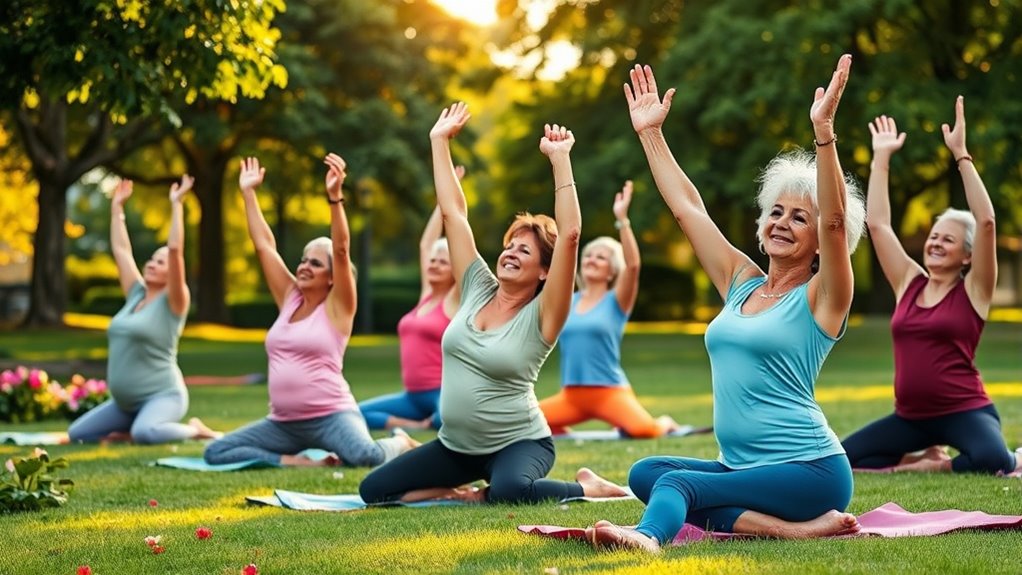
While maintaining flexibility can be challenging as we age, incorporating regular stretching routines into your daily life can greatly enhance your overall well-being.
Daily stretching exercises improve your range of motion and comfort in everyday activities. Focus on neck stretches to relieve tension and upper back stretches to alleviate shoulder stiffness. Aim to hold each stretch for 10 to 30 seconds, repeating 3 to 5 times for maximum effectiveness. Additionally, incorporating essential oils for flexibility can help create a soothing environment that enhances your stretching routine. Engaging in renewable energy sources can also provide a more sustainable lifestyle, contributing positively to overall well-being. Including hydration through freshly squeezed juices can also support muscle function and recovery, making it easier to stay active. It’s essential to remain aware of sexual health risks that may impact your overall health and activity levels as you age.
This flexibility training boosts your mobility and helps prevent stiffness, which is essential for maintaining independence. Additionally, activities like yoga and tai chi not only improve flexibility but also promote relaxation and mindfulness, benefiting both your physical and mental health. Engaging in these practices can also help you align with vibrational youthfulness, fostering a sense of vitality and energy as you age.
Low-Impact Cardio Options
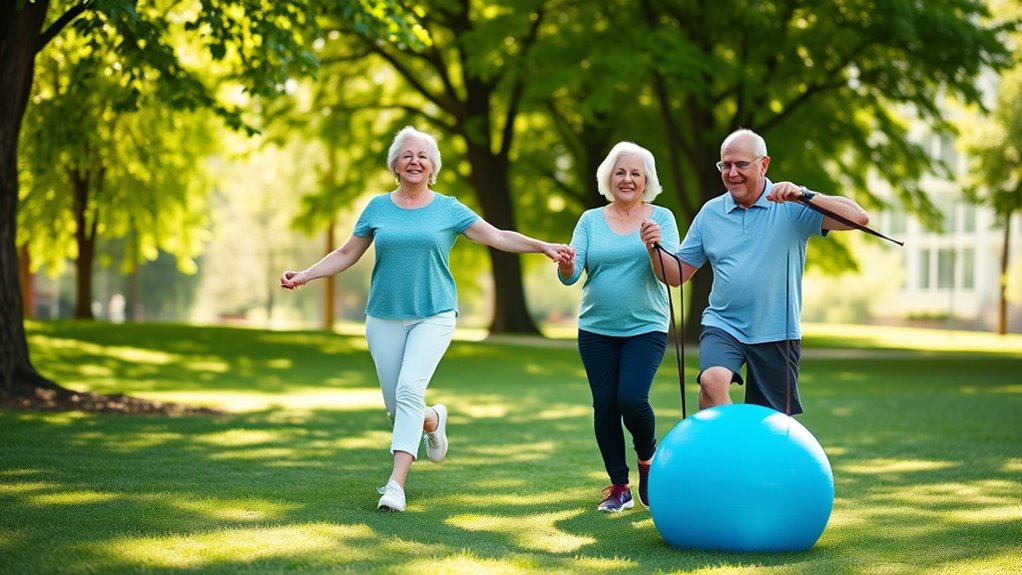
When it comes to staying active, low-impact cardio options are perfect for you.
Activities like swimming, cycling, and fun group exercises can boost your heart health without putting stress on your joints. In addition, creating cozy spaces can enhance your exercise experience by providing a comfortable environment that encourages regular activity.
Let’s explore how these gentle aerobic activities can fit into your routine and help you stay fit and engaged.
Gentle Aerobic Activities
Gentle aerobic activities are an excellent way for seniors to stay active and improve their overall health.
These low-impact cardio options are perfect for enhancing cardiovascular health without straining your joints.
Here are three enjoyable activities you might consider:
- Walking: A simple daily walk can boost your energy levels and fit easily into your routine.
- Water Aerobics: Enjoy a fun group class that combines social interaction with effective low-impact exercise, keeping you engaged and active.
- Tai Chi or Dance Classes: These activities not only enhance balance but also improve coordination, reducing the risk of falls.
Incorporating these activities into your week can help maintain an active lifestyle while promoting overall well-being.
Swimming and Cycling
Swimming and cycling offer fantastic low-impact cardio options for seniors looking to stay active and healthy. Both activities help improve cardiovascular health while minimizing stress on your joints, making them ideal if you have arthritis or osteoporosis. Regular swimming can even support cognitive function, enhancing your overall health. Cycling, whether outdoors or on a stationary bike, boosts leg strength and aids in weight management.
Here’s a quick comparison:
| Activity | Benefits | Accessibility |
|---|---|---|
| Swimming | Low-impact, joint-friendly | Adjustable intensity |
| Cycling | Enhances leg strength, cardio | Suitable for all fitness levels |
| Both | Aids weight management, metabolism | Encourages active lifestyle |
Engaging in swimming and cycling can greatly contribute to your fitness journey as an older adult.
Fun Group Exercises
How can you make exercise more enjoyable while staying active? Fun group exercises offer a fantastic way to engage in low-impact cardio while fostering social interaction. Here are three great options to evaluate:
- Zumba Gold: This lively dance class is tailored for seniors, promoting cardiovascular health with fun music.
- Water Aerobics: Exercising in water reduces joint strain, making it a perfect low-impact option that encourages community involvement.
- Chair Aerobics: Perfect for those needing accessibility, this class improves senior fitness without the risk of injury.
Programs like SilverSneakers Classic provide these options, ensuring everyone can participate.
Engaging in group activities not only boosts physical health but also enhances mental well-being, reducing feelings of isolation and elevating your mood.
Safety Tips for Exercising

When you’re ready to start exercising, prioritizing safety is essential to guarantee a positive experience. Always consult a healthcare provider before beginning any new exercise program, especially if you have pre-existing conditions.
Start with low-impact exercises and gradually increase intensity, paying attention to how your body feels. Use supportive footwear and, if necessary, stability aids like chairs or handrails to avoid injuries.
Remember to monitor symptoms such as fatigue or dizziness during your workouts, and stop immediately if anything feels off. Schedule regular rest days between strength training sessions to allow muscles to recover.
Following these safety tips will help ensure that you enjoy your exercise program while staying fit and healthy.
Resources for Seniors to Stay Active
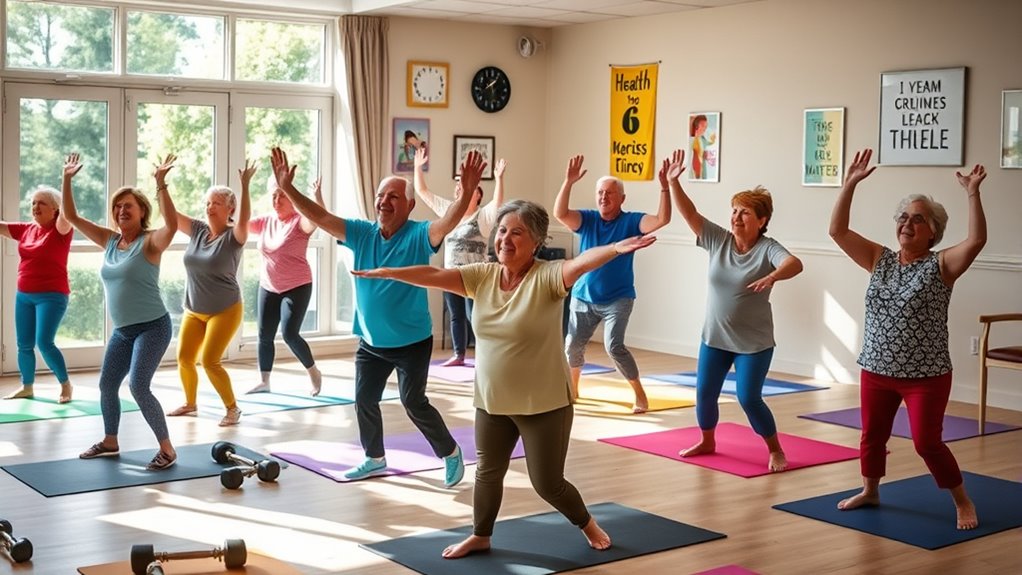
Staying active as a senior is essential for maintaining health and well-being, and there are plenty of resources available to help you do just that.
Here are three great options to contemplate:
- SilverSneakers: This program provides access to free On-Demand workout videos and community fitness classes that cater specifically to seniors.
- Active Choices and EnhanceFitness: These programs focus on group exercise and tailored support, making it easier for you to incorporate regular exercise into your life.
- Tai Chi and Walk with Ease: These activities improve balance and strength while reducing fall risks, ensuring you stay safe during your fitness journey.
Embracing these resources will lead to significant health benefits and help you stay active in your daily activities.
Frequently Asked Questions
What Is the Number One Exercise for Seniors?
The number one exercise for seniors is walking. It’s an easy, low-impact activity that you can fit into your daily routine.
Research shows that hitting 10,000 steps a day can markedly boost your overall health and lower your mortality risk. Walking improves cardiovascular health, strengthens your muscles, and increases joint flexibility.
You can start at your own pace, making it a great way to stay active and even socialize with friends.
What Is the Best Workout Program for Seniors?
Imagine planting a garden; you need a mix of seeds to thrive.
Similarly, the best workout program for you includes a balance of 150 minutes of moderate aerobic activity and strength training twice a week. Think walking, swimming, or cycling for your heart, alongside wall push-ups and chair squats to build strength.
Don’t forget balance exercises like yoga and tai chi to keep you steady. Join a class for motivation and social fun!
What Is the Number 1 Exercise to Increase Balance in Seniors?
The number one exercise to increase balance in seniors is the single-leg stand.
By standing on one leg for 10 to 30 seconds, you enhance your stability and coordination.
It’s simple to incorporate into your routine, and doing it at least three times a week can greatly reduce your risk of falls.
What Exercise Burns the Most Belly Fat for Seniors?
Burning belly fat’s like trying to extinguish a stubborn fire; it takes consistent effort.
For seniors, combining aerobic exercises like brisk walking or swimming with strength training can be highly effective. Aim for at least 150 minutes of moderate-intensity activity weekly, plus two days of resistance exercises.
Incorporating High-Intensity Interval Training (HIIT) can also help, as it’s adaptable and efficient.
Conclusion
Staying active as a senior is like tending to a garden; the more you nurture it, the more vibrant it becomes. Just like flowers need sunlight and water, your body needs regular exercise to thrive. By incorporating strength training, balance, and flexibility exercises into your routine, you’re not just adding years to your life—you’re adding life to your years. So, lace up those sneakers and start your journey to fitness; your future self will thank you!
